NCERT Solutions for Class 7 English Unit 1 The Day the River Spoke
Let us do these activities before we read. (Page 1)
I. Close your eyes and quietly listen to the sounds around you for a minute.
Q1: Are they trying to tell you something?
Ans: Yes, the sounds around us can often communicate different messages. 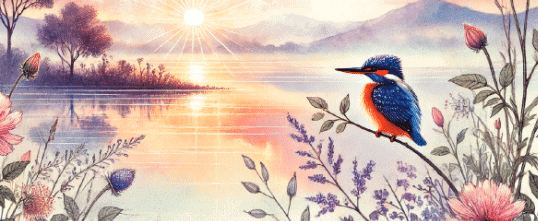
- For example, birds chirping might be a sign that it’s morning or the start of a new day.
- The rustling of leaves could mean that the wind is blowing gently.
- Traffic noises might suggest that people are going about their daily activities.
- Even the sound of water flowing could tell us that a river or stream is nearby.
- Each sound can give us a clue about what’s happening around us or what time of day it is!
Q2: Do you think the things around you also listen to you all day long?
Ans: Things like trees, rivers, or animals don’t listen like humans, but it feels like they do when we talk to them or spend time with them.
II. Jahnavi was a bright young girl who lived with her parents and three brothers in a coastal village in India. Her parents worked on the farm. She had a dream.
Q1: What could that dream be?
Ans: Jahnavi's dream could be something that she wants to achieve in life, like becoming a teacher, a doctor, or even traveling the world. She might dream of something that excites her or helps others in her community.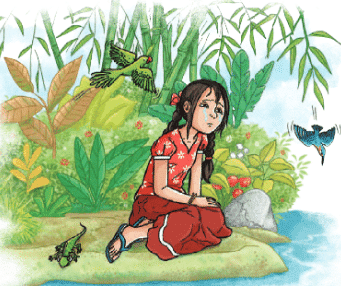
Q2: How could she make her dream come true?
Ans: To make her dream come true, Jahnavi would need to work hard and stay focused. She could learn from others, read books, ask questions, and practice the skills needed to reach her goal.
Q3: What is your dream? What can you do to make your dream come true?
Ans: My dream is to become a doctor. I can study hard, focus on science, and ask for help from teachers to achieve it. (Answers may vary based on personal dreams.)
Let us discuss (Page 3)
Q1: What was Jahnavi’s dream? Was it important to her? Why?
Ans: Jahnavi’s dream was to go to school and learn to read and write. It was important to her because she wanted to understand things like why spiders are yellow, why bamboo rustles, and other questions. Learning would make her happy and help her feel equal to her siblings.
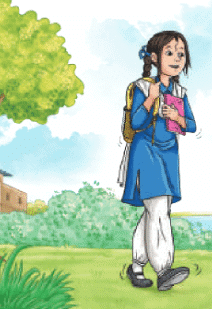
Q2: Do you think the river can help her in fulfilling her dream? How?
Ans: Yes, the river helps Jahnavi by encouraging her to be brave and go to school. It tells her to try sitting in class and listening, which gives her the courage to take the first step toward her dream.
Let us discuss (Page 6)
Complete the table given below with Jahnavi’s questions in Column 1 and the River’s answers in Column 2.
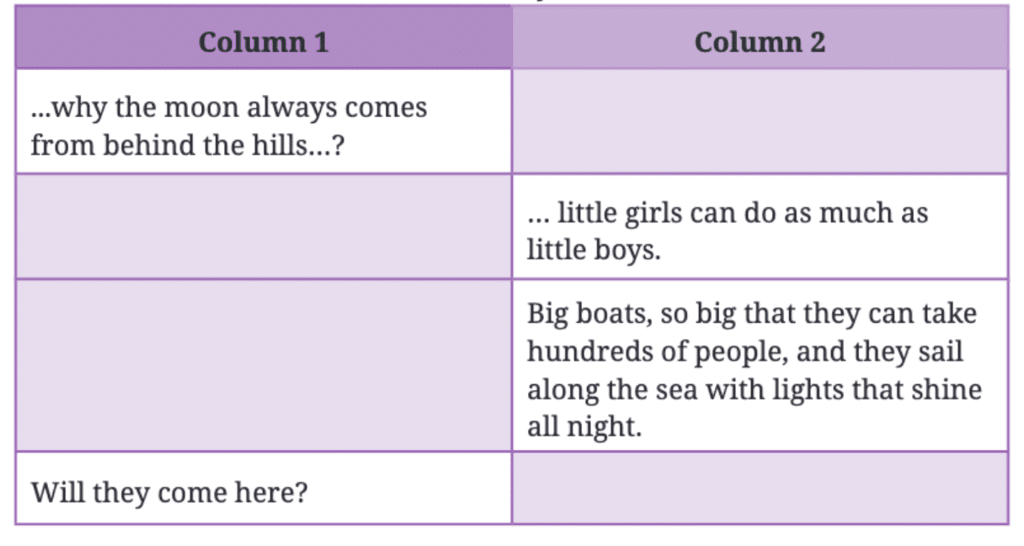
Ans:
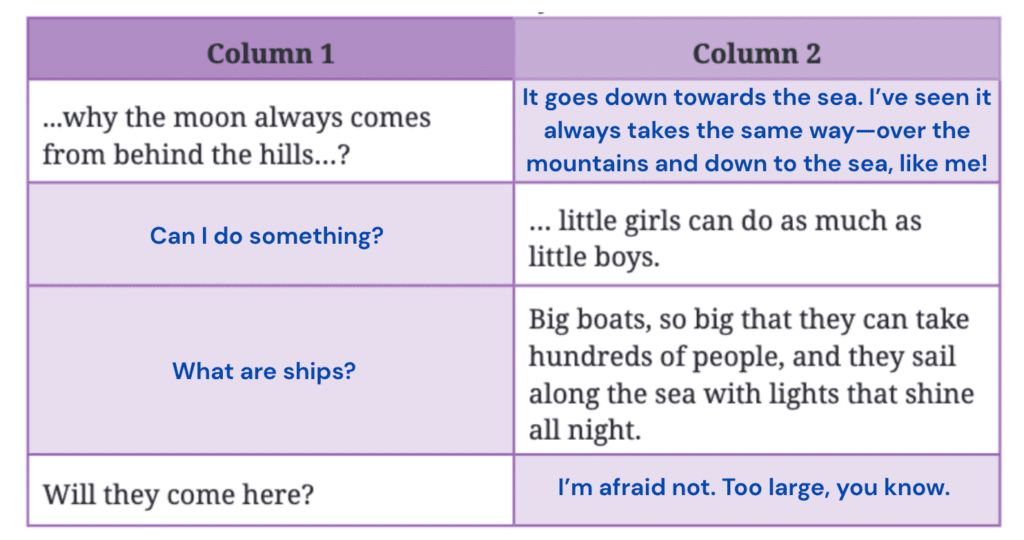
Let us think and reflect (Page 7)
I. Read the extracts given below and answer the questions that follow.
1. “You shouldn’t cry, you know,” the voice went on. “And you really shouldn’t be scared, when you have been coming here to see me everyday, well, almost every day.” She was puzzled. It was such a voice, like the river. It couldn’t be the river! “Well, tell me all about it,” said the River, for it was the River. “I’ve got to hurry to reach the sea, you know.”
(i): The tone of the River in the given extract is (assuring/sympathising)
Ans: The tone of the River is assuring.
(ii): Select a phrase from the extract which shows that Jahnavi was a frequent visitor to the spot.
Ans: “when you have been coming here to see me every day, well, almost every day.”
(iii): The use of an exclamation mark at the end of the line, ‘It couldn’t be the river!’ expresses ___________
A. excitement B. hesitation C. irritation D. disbelief
Ans: D. disbelief
(iv): Choose three qualities of the River highlighted in the extract from the words in the box given below.

Ans: affectionate, thoughtful, kind-hearted
2. “Can I do something?” asked Jahnavi. “Well, it’s up to you,” said the River. “Seems to me little girls can do as much as little boys—they swim as fast as little boys. You just slip along one morning and sit there in the school and listen to what’s going on, and maybe the teacher will let you stay.”
“I couldn’t,” gasped Jahnavi. “I couldn’t! They’d scare me! They’d chase me out.”
(i) According to the River, there was no difference between girls and boys because ____________
Ans: little girls can do as much as little boys, like swimming as fast as them.
ii) Identify whether the following statement is true or false.
The River encourages Jahnavi to have faith in herself and fulfil her desire to go to school.
Ans: True
(iii): When the River suggests that Jahnavi should ‘slip along’, it means that she should move
A. quickly B. casually C. quietly D. confidently
Ans: C. quietly
(iv): What does the repetition of the phrase “I couldn’t” tell us?
Ans: It shows Jahnavi’s fear and lack of confidence about going to school, thinking she will be scared or chased away.
II. Answer the following questions
Q1: Why does the writer describe different aspects of nature in great detail at the beginning of the story? Why do you think the writer does this?
Ans: The writer describes nature, such as the kingfisher, lizard, and river, to set a lively and peaceful atmosphere. This helps readers feel connected to Jahnavi's world and highlights how nature, especially the river, plays a significant role in her life.
Q2: How did the River know so much about Jahnavi?
Ans: The River knew so much about Jahnavi because she visited it almost every day, sharing her thoughts and feelings. The River had been a silent listener and understood her dreams and fears.
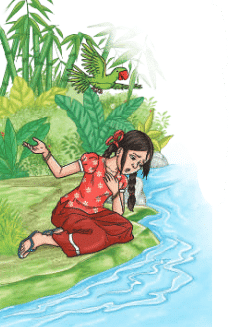
Q3: Jahnavi says, “And I’m so old now, they’ll never let me go.” What can you infer about Jahnavi and the school from this line?
Ans: Jahnavi feels she is too old to start school. Since she is nearly ten and has never been allowed to attend, she might believe that it’s too late for her to start learning. This suggests that the school may not easily accept older children who haven't had the chance to study earlier.
Q4: Why did the River laugh when Jahnavi said she would be scared at school?
Ans: The River laughed because it knew Jahnavi had already faced challenges in nature, like lizards, snakes, and trains, and had been brave. The River found it funny that she was scared of going to school, which seemed far less dangerous compared to what she had already encountered.
Q5: Why should Jahnavi follow the River’s advice?
Ans: Jahnavi should follow the River’s advice because it encourages her to be brave, take the first step towards her goal, and believe in herself. This can help her achieve her dream of going to school despite her fears.

Q6: How does the conversation between Jahnavi and the River make the story more appealing?
Ans: The conversation makes the story more appealing by giving the River a voice, making it feel wise and friendly. This adds a magical element to the story, as the River becomes a character that supports and encourages Jahnavi, keeping the readers engaged.
Q7: What is the main message that the writer intends to convey?
Ans: The main message is that with courage and determination, anyone can overcome obstacles and achieve their dreams. The story particularly highlights how girls, who may face barriers to education, can break those barriers with courage and determination.
Let us learn (Page 8)
Q1: Why has the author used a capital letter for the ‘River’ even when it is a common noun? (Clue: Has the River been given qualities of a human being?)
Ans: The author uses a capital letter for ‘River’ because it is given human qualities, like talking, laughing, and giving advice, making it a character like a person.
Q2: There are a few words related to sound in the text. Pick the words from the text and write them next to the correct definition.
1. made a high-pitched piercing sound
Ans: shrieked
2. to cause liquid to strike or fall on something
Ans: splashed
3. a low continuous background noise
Ans: murmuring
4. cry with loud uncontrollable gasps
Ans: sob
5. to make a soft dry sound, like paper or leaves moving
Ans: rustle
6. took a short quick breath through the mouth due to surprise, pain or shock
Ans: gasped
7. shaking rapidly to make continuous short, sharp sounds
Ans: rattling
8. making a lot of noise
Ans: noisy
9. made a long, high cry, usually because of pain or sadness
Ans: wailed
Fill in the blanks with suitable sound words from exercise (II).
The classroom grew (i) noisy as the students noticed the teacher carrying the answer papers. As the teacher turned the pages with a (ii) rustle, the children (iii) gasped, wondering what comments awaited. Someone (iv) sobbed in frustration, and the (v) murmuring of the students steadily increased. Finally, when the teacher praised the students for their excellent performance, the students (vi) shrieked with excitement.
Q3: The word ‘catamaran’ is used in the text. The word originates from Tamil language ‘kattu maram’ meaning ‘tied wood’. Find out the meanings of these words. From which Indian language these words were borrowed.
1. karma (Sanskrit)
Ans: Meaning: Action or deed that affects future life. Language: Sanskrit
2. sahib
Ans: Meaning: Respectful address for a man, like ‘sir’. Language: Hindi/Urdu
3. chutney
Ans: Meaning: A spicy sauce or relish. Language: Hindi
4. guru
Ans: Meaning: A spiritual teacher or guide. Language: Sanskrit
5. verandah
Ans: Meaning: An open porch or balcony. Language: Hindi/Portuguese
6. jungle
Ans: Meaning: A dense forest or wilderness. Language: Hindi
7. areca
Ans: Meaning: A type of palm tree or its nut. Language: Malayalam
8. palanquin
Ans: Meaning: A covered seat carried by people. Language: Hindi/Sanskrit
Q4: Chandu, the fisherman, has a catamaran that the River preferred to a ship. Given below are some boats that are used in different parts of our country.

(i) Which one would you like to travel in?
Ans: I would like to travel in a shikara because it looks beautiful and peaceful on lakes like Dal Lake. (Answers may vary.)(ii) Make a colourful drawing of a boat that you would like to travel in.
Ans: (This is a drawing activity, so no written answer is required.)
Q5: Solve the crossword puzzle based on words related to water transport.
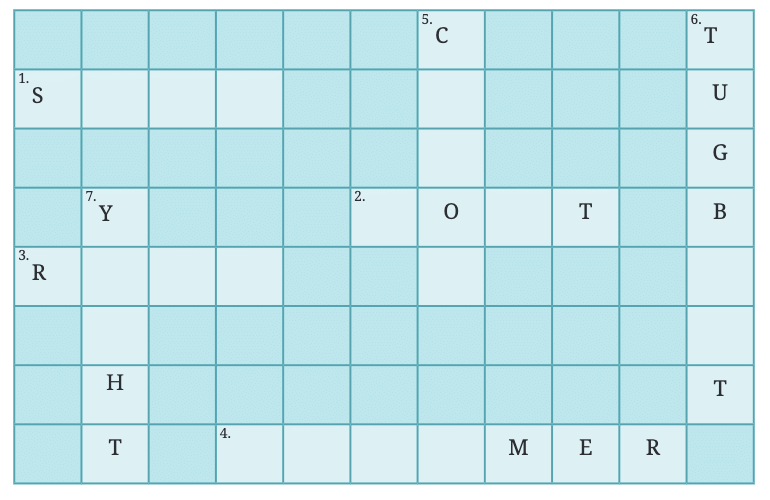
Ans:
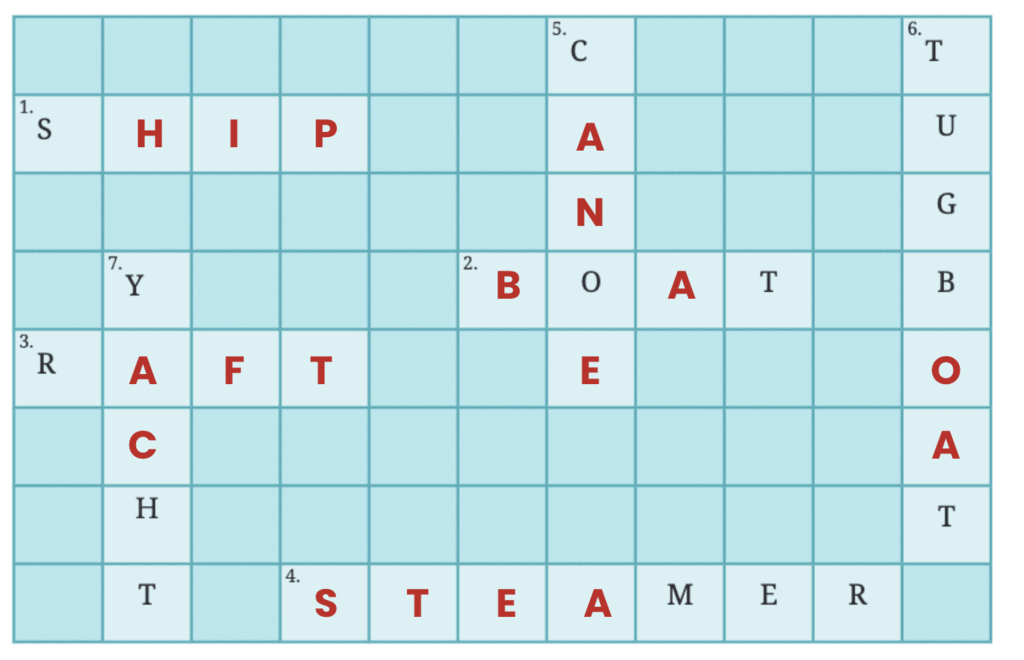
Q6. Read the highlighted words in the following lines from the text.
“She goes down towards the sea. I’ve seen her; she always takes the same way—over the mountains and down to the sea, like me!”
Prepositions are words that indicate the relationship between nouns or pronouns and other elements in a sentence. They show direction, location, time or logical relationships between ideas.
Now, fill in the blanks with suitable prepositions given within the brackets.
Jahnavi takes the River’s advice and goes to school. On her first day 1. _________ (at/in/on) school, Jahnavi stood nervously 2. _________ (in/outside/above) the gate, clutching her bag close to her. The bell rang and she hurried 3. _________ (outside/through/inside) the bustling classroom. She found a seat 4. _________ (among/between/from) two friendly classmates. The teacher greeted them warmly and started the lesson 5._________ (about/in/for) numbers. Jahnavi listened attentively, feeling excited 6. _________ (at/about/for) the new adventure ahead.
Ans:
Jahnavi takes the River’s advice and goes to school. On her first day 1. at (at/in/on) school, Jahnavi stood nervously 2. outside (in/outside/above) the gate, clutching her bag close to her. The bell rang and she hurried 3. inside the bustling classroom. She found a seat 4. between two friendly classmates. The teacher greeted them warmly and started the lesson 5. about numbers. Jahnavi listened attentively, feeling excited 6. about the new adventure ahead.
Q7: Read the highlighted words in the following sentence from the text.
A kingfisher swept down, its wings a narrow of blue in the sunlight. Words like on, off, up, down can function both as prepositions and as adverbs. For example:
She ran up the stairs. (preposition)

She rang me up. (adverb)

Remember, a preposition will always be followed by an object (noun), whereas an adverb will tell you more about the action (verb).
Fill in the blanks with prepositions or adverbs.
1. The cat jumped ___________ the table. (preposition)
Ans: The cat jumped onto the table.
2. The children played ___________ until dark. (adverb)
Ans: The children played on until dark.
3. She quickly ran ___________ the park. (preposition)
Ans: She quickly ran to the park.
4. The helicopter was hovering ___________. (adverb)
Ans: The helicopter was hovering above.
5. We were just walking ___________, chatting. (adverb)
Ans: We were just walking along, chatting.
6. After thoroughly wiping his shoes, he stepped ___________. (adverb)
Ans: After thoroughly wiping his shoes, he stepped inside.
7. She drove slowly ___________ the sharp curve. (preposition)
Ans: She drove slowly around the sharp curve.
8. He placed the keys ___________ the mat before leaving. (preposition)
Ans: He placed the keys on the mat before leaving.
Let us listen (Page 12)
(I) Read the words given in the box below. You will listen to five people speak about school life. As you listen, circle the words that are used by the speakers. There are two words you do not need. (Transcript for the teacher is given below)

- Speaker (i): (Father) Should girls attend school? Yes, they should. I do my best to ensure that both my son and daughter get equal opportunities. I look forward to their successful careers and rewarding lives. I feel education gives freedom to make choices in life. Whether my daughter wants to work in an organisation or be a homemaker, it should be her choice and the same applies to my son.
- Speaker (ii): (Grandmother) I went to school but many girls at that time could not attend school because some elders in the village felt that girls should help in the house and take care of their little brothers and sisters. I am happy that the situation has changed today.
- Speaker (iii): (Teacher) The school prepares students for meaningful and useful participation in the world of work by learning hands-on abilities and skills, developing equal respect for head-hands-heart, valuing the dignity of labour, and understanding vocational choices for the future.
- Speaker (iv): (Student) I like to go to school. I feel that by coming to school and reading the books, I learn about things from all over the world. I also have friends with whom I can share my feelings.
- Speaker (v): (Principal) Everyone should attend school. You must’ve noticed that the girls are doing very well. However, as the Head of an institution, I know that all students can work hard. My message to students is that they should attend school regularly and take part in every school activity without bothering whether it is for girls or boys. The idea is to focus on learning.
Ans: 
The words used by the speakers from the box are:
- careers (by the father)
- homemaker (by the father)
- books (by the student)
The words not used are:
- lawyer
- desks
- principal
- posters
- newspapers
- marriage
- advertisements
(II) You will once again listen to the five speakers. As you listen, match each statement 1–7 to each speaker (i)–(v). There are two statements that you do not need.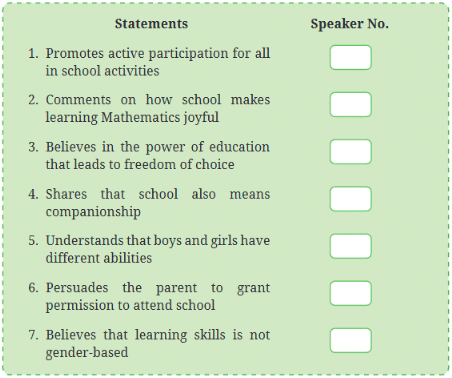
Ans:
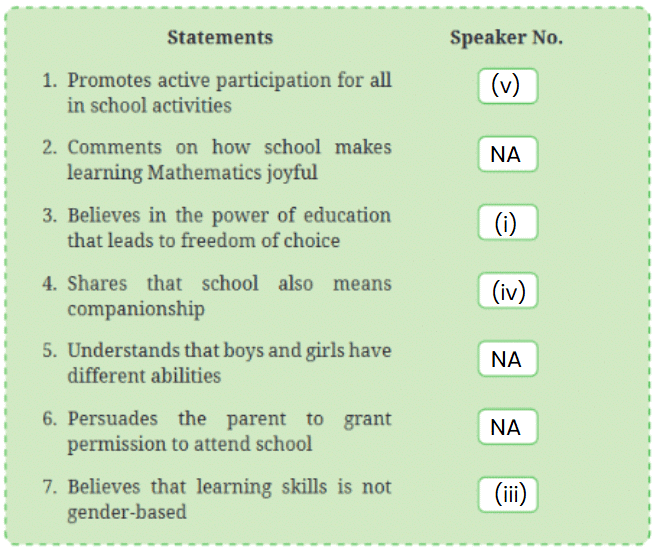
- Statement 1: The principal wants all students to join school activities, so this matches Speaker (v).
- Statement 2: No one talks about Mathematics, so this is not used.
- Statement 3: The father says education helps his children choose what they want to do, like work or be a homemaker, so this matches Speaker (i).
- Statement 4: The student talks about friends at school, which means companionship, so this matches Speaker (iv).
- Statement 5: No one says boys and girls have different abilities—they all talk about equal chances—so this is not used.
- Statement 6: No one is trying to convince a parent to let their child go to school. The grandmother talks about the past, and the father already agrees girls should go to school, so this is not used.
- Statement 7: The teacher says school teaches skills to all students for work, not just boys or girls, so this matches Speaker (iii).
- The grandmother (Speaker ii) doesn’t have a matching statement because she only talks about how things were in the past, which doesn’t fit any of the given statements.
Note: The question expects 5 matches, but we only matched 4 statements because the grandmother’s statement doesn’t fit any of the options. Since we need 2 statements to be unused, and we have 3 unused statements (2, 5, and 6), this still works. If your teacher has more details, you can ask them!
Let us speak (Page 13)
Q1: The River spoke to Jahnavi in a ‘sleepy’ voice. Work in pairs and take turns to speak the same sentence in ‘other’ voices. Some hints are given below: happy, surprised, angry, scared, sad, worried.
Ans: (This is a speaking activity, so no written answer is required. Students practice saying the River’s lines in different tones.)
Q2: Janhavi asks the River for advice and the River gives advice. Read the given situations and work in pairs to ask for and give advice. Take turns to change your roles.
Situation (i): You wish to play football at school but it has an all-boys’ team only.
Ans:
Asking: What do you think I should do about joining the football team? It’s only for boys.
Giving: I think you should talk to the coach and ask if girls can try out. You’re just as good as the boys!
Situation (ii): You have been unable to score well in Mathematics due to nervousness during exams.
Ans:
Asking: Do you think I should do something about my nervousness in Maths exams?
Giving: Why don’t you practice deep breathing before the exam to stay calm?
Situation (iii): You really enjoy music classes but do not get enough time to practise for it.
Ans:
Asking: What would you do if you loved music but had no time to practice?
Giving: The best thing to do is set a small time each day, like 15 minutes, to practice music.
Situation (iv): You cannot see the blackboard clearly from the last bench.
Ans:
Asking: I’d appreciate your advice on not seeing the blackboard from the last bench.
Giving: If I were you, I would politely ask the teacher to move to a closer seat.
Let us write (Page 14)
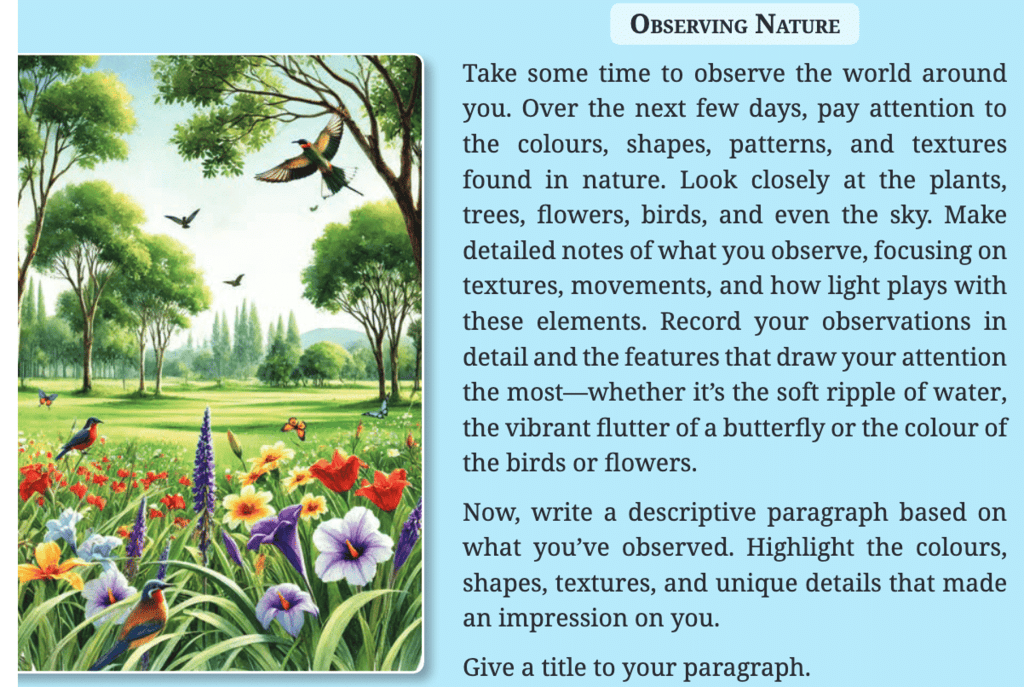
Ans: The Dancing River
Every day, I see the river near my house, sparkling under the sun like a silver ribbon. Its water ripples softly, making a gentle gurgling sound, and feels cool when I touch it. The green leaves of trees along the bank sway in the breeze, their rough bark contrasting with the smooth pebbles on the shore. I find it very interesting that tiny fish dart in the clear water, their scales shining like rainbows. I feel peaceful watching the river flow, as it seems to carry away all worries. My advice to all is to spend time with nature to feel calm and happy.
(Note: This is a sample response; actual answers will vary based on personal observations.)
Let us explore (Page 14)
(I) Discuss why rivers in India are considered to be sacred and most of them are referred to as female. Some rivers are referred to as male, for example, the Brahmaputra and the Sone.
Ans: Rivers in India are sacred because they give life, water crops, and are part of religious stories. Many, like Ganga and Yamuna, are seen as female goddesses who nurture and protect. Some, like Brahmaputra and Sone, are called male, possibly due to their strength or myths associating them with male gods.
(II) Whole Class Activity
Q1. India is a multilingual country, and many of us can speak two to three languages easily. Make a list of the languages that everyone in the class can speak and display it on a chart paper in the classroom.
Sample answer/idea: Here is a list of languages that most of the students in the class can speak:
- Hindi
- English
- Punjabi
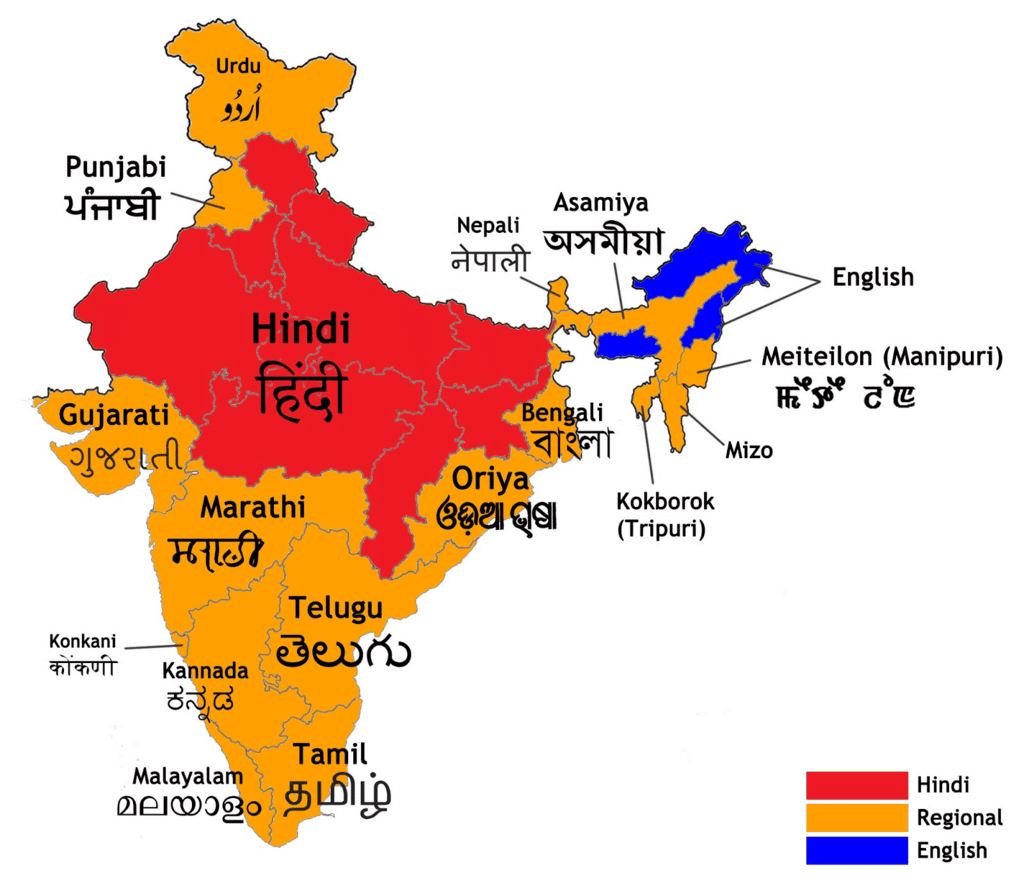
Q2. In which language do you enjoy reading and learning the most?
Sample answer/idea:
- Many students may say English, especially if the textbook and classroom instruction are in English.
- Some may prefer their mother tongue or regional language, like Hindi, Tamil, Marathi, etc., because it is easier to understand and relate to.
- Some may enjoy bilingual reading, using both English and their native language.
Example student responses:
- "I enjoy reading and learning in English because most of my books are in English."
- "I like reading in Hindi because I understand the stories better."
- "I enjoy learning in Tamil because it is my first language and I can read quickly."
(III) Read the poster given below and answer the questions that follow.
Q1. What can you see in the poster?
The poster shows four girls who look very happy. They are smiling and sitting close to each other. The girls are holding a pencil and writing in a notebook, so they might be studying or learning. They are wearing colorful clothes, and the simple background suggests they are in a classroom. There is a message on the poster that says, "The Happiness of a Nation lies in the Dignity of its Daughters," written in white and orange letters on a teal and orange background.
Q2. Why do you think the girls look happy?
The girls look happy because they might be learning something new, like studying or writing, which makes them feel good. They are smiling, so they probably feel safe and cared for. Maybe they have nice teachers or friends who make them laugh and feel important.
Q3. Dignity means ‘self-respect’. What is the relation between ‘dignity’ and ‘happiness’?
Dignity means feeling proud of yourself and being respected by others. When the girls are treated nicely and given chances to study and grow, they feel good about themselves—this is dignity. When they have dignity, they feel happy because they know they are important and loved. So, dignity makes happiness grow, just like sunlight helps a plant grow!
Q4. How does a Nation prosper when its daughters are happy?
When a nation’s daughters are happy, it means they are healthy, going to school, and learning new things. Happy girls can grow up to be smart women who do great things, like becoming doctors, teachers, or leaders. They can help their families and make their country better. If girls are happy, everyone in the nation feels happier, and the country becomes stronger and more successful because everyone works together.
(IV) The Government has launched many schemes for the education of the girl child. Some of them are ‘Beti Bachao Beti Padhao’, ‘Balika Samridhi Yojana’, ‘Samagra Shiksha Scheme–Kasturba Gandhi Balika Vidyalayas’, etc. Find out more such schemes from the internet or from your teacher and spread awareness in your neighbourhood
Ans: The Government of India has started many schemes to help girls go to school and learn. Some schemes you already know are ‘Beti Bachao Beti Padhao’, ‘Balika Samridhi Yojana’, and ‘Samagra Shiksha Scheme–Kasturba Gandhi Balika Vidyalayas’. Let’s learn about a few more schemes that help girls like you study and grow strong. Then, you can tell your friends and neighbors about them to spread awareness!
- Sukanya Samriddhi Yojana (SSY)
This is a savings plan for girls. Parents can open an account for a girl under 10 years old at a post office or bank. They can save money for her education or marriage. The money grows with a good interest rate, around 8.2% in 2025, and can be taken out when the girl turns 21 or gets married after 18. It helps parents plan for a girl’s future so she can study well and be happy.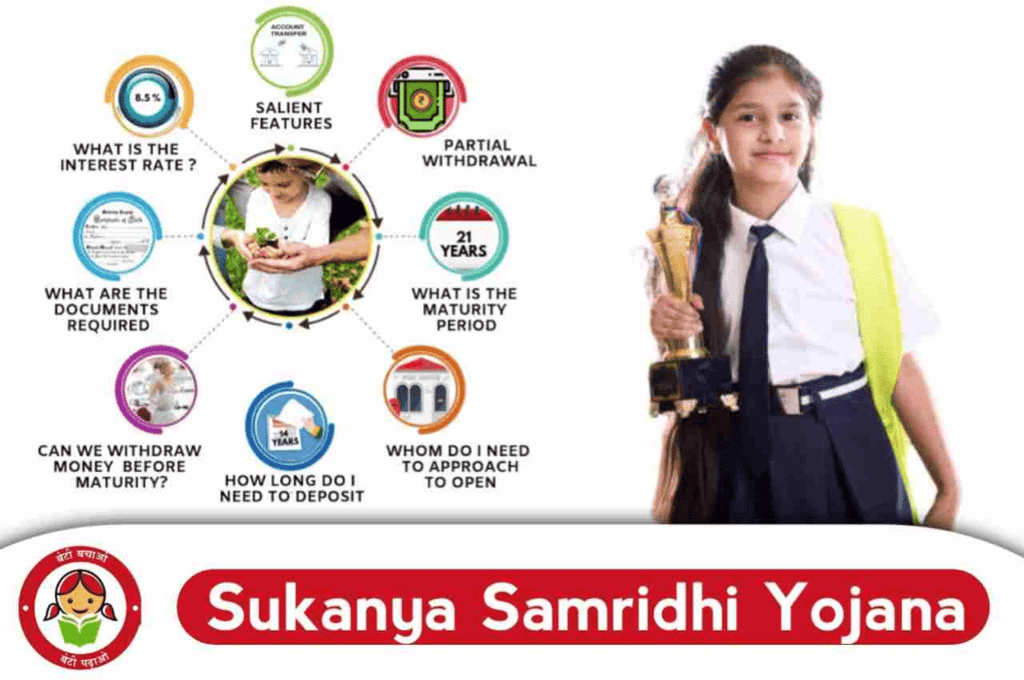
- CBSE Udaan Scheme
This scheme helps girls who want to become engineers. It’s for girls from weaker families who are in Class 11 or 12. The government gives free study materials, videos, and classes to help them prepare for engineering exams like IIT or NIT. If a girl gets into a good college, she can also get money for fees and hostel costs. It helps girls dream big and study hard! - National Scheme of Incentive to Girls for Secondary Education (NSIGSE)
This scheme is for girls who have passed Class 8 and are between 14 to 18 years old. It gives Rs. 3,000 to girls from SC/ST families or those who studied in Kasturba Gandhi Balika Vidyalayas. The money is kept in a bank and can be taken out with interest when the girl turns 18 and passes Class 10. It helps girls stay in school and not drop out. - Rajiv Gandhi Scheme for Empowerment of Adolescent Girls (SABLA)
This scheme is for girls aged 11 to 18 years. It helps them learn life skills, stay healthy, and eat good food. It also teaches them about hygiene and gives them training for jobs. Girls can join this scheme through Anganwadi Centers. It makes girls strong and ready for a bright future.
How to Spread Awareness in Your Neighborhood:
- Tell Your Friends and Family: Share what you learned about these schemes with your friends, parents, and neighbors. Explain how they can help girls study and grow.
- Make Posters: Draw simple posters with the names of these schemes and what they do. Stick them in your building or near your home where people can see them.
- Talk to Your Teacher: Ask your teacher to tell the class about these schemes so everyone knows. Maybe your school can have a small event to talk about girls’ education.
- Visit an Anganwadi Center: Go with your parents to a nearby Anganwadi Center and ask them about these schemes. They can help tell more families in your area.
When girls study and are happy, they can do great things for their families and the country. Let’s tell everyone about these schemes so more girls can go to school and shine!
|
55 videos|468 docs|76 tests
|
FAQs on NCERT Solutions for Class 7 English Unit 1 The Day the River Spoke
| 1. What is the main theme of "The Day the River Spoke"? |  |
| 2. How does the river in the story express its feelings? |  |
| 3. What lessons can be learned from the interaction between the river and the people? |  |
| 4. Who are the main characters in "The Day the River Spoke," and what roles do they play? |  |
| 5. How can readers relate to the story's message about nature? |  |

















